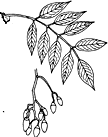| DESCRIPTION: It can reach up to 1.5 m in height and 0.6 m in width. It is in flower from August to October, and the seeds ripen in October. The flowers are hermaphrodite. USE: The root can be used cooked. The source of 'canna starch', used as an arrowroot. The arrowroot is obtained by rasping the root to a pulp, then washing and straining to get rid of the fibres. The very young tubers are eaten cooked, they are sweet but fibrousy. Roots contain about 25% starch. The root has demulcent, diaphoretic and diuretic properties and is used for women's complaints. A fibre obtained from the leaves is used for making paper. The leaves are harvested in late summer after the plant has flowered, they are scraped to remove the outer skin and are then soaked in water for 2 hours prior to cooking. The fibres are cooked for 24 hours with lye and then beaten in a blender. They make a light tan brown paper. A purple dye is obtained from the seed. GROWING PERIOD: Perennial. COMMON NAMES: Indian shot, Achira Roja, Balisier Rouge, Canne Indienne. FURTHER INF: It can be found in South America and the Caribbean. Locally naturalized in the warmest parts of South Europe. Original habitat is obscure, but it is found by the coast and in temperate valleys of the Andes. It can be found in woodland, cultivated beds, sunny edge, by southern and western walls. The plant has large leaves and dislikes windy conditions since this can tear the leaves to shreds. |
